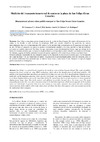Please use this identifier to cite or link to this item:
https://accedacris.ulpgc.es/jspui/handle/10553/106691
| Title: | Medición del transporte transversal de cantos en la playa de San Felipe (Gran Canaria) | Other Titles: | Measurements of cross-shore pebble transport at San Felipe beach (Gran Canaria) | Authors: | Casamayor Font, Mariona Alonso Bilbao, Ignacio Sánchez García, María José Cabrera, J. Rodríguez, S. |
UNESCO Clasification: | 251090-1 Geología marina. Dinámica sedimentaria | Keywords: | Berm Cross-shore displacement RFID Wave Pebbles |
Issue Date: | 2015 | Publisher: | Sociedad Geológica de España | Journal: | Geotemas (Madrid) | Conference: | VIII Jornadas de Geomorfología Litoral | Abstract: | San Felipe es una playa mixta situada al norte de la isla de Gran Canaria. El estudio del transporte de los cantos se ha llevado a cabo mediante la tecnología RFID que permite identificar las partículas de manera individualizada. Para ello se han marcado 198 cantos y se ha monitorizado su transporte en 15 ocasiones a lo largo de un año. Si bien el transporte de cantos se produce principalmente paralelo a la costa, también se dan movimientos relevantes en sentido transversal. De éstos, los que representan mayor desplazamiento tienen lugar por debajo de la berma de tormenta mientras que los menores desplazamientos corresponden a cantos situados por encima de la berma. No obstante, algunas de dichas partículas recorren distancias superiores a 20 m tanto hacia el mar como hacia tierra. El factor principal responsable de este transporte parece ser la migración de la cresta de la berma, que a su vez depende del oleaje incidente y de las condiciones de marea. En general no se aprecia ningún patrón claro de transporte, pues en las mismas condiciones hay partículas que se mueven hacia tierra y otras hacia el mar. Tampoco se aprecia ningún patrón estacional en el transporte. San Felipe is a mixed beach located in the northern coast of Gran Canaria Island. This study of pebbles transport has been carried out using RDIF technology, which allows the identification of individual particles. 198 pebbles were tagged and their movement was monitored 15 times over one year. Even though pebbles transport occurs preferably on the longshore direction, there are also significant cross-shore movements. Results show that the larger cross-shore displacements occur on the beach face below the storm berm, but in certain occasions we have measured displacements larger than 20m (both onshore and offshore) in pebbles located above the berm crest. The main responsible factor for this cross-shore transport seems to be the berm migration, which in turn depends on the incident waves and tidal height. In general, there is no clear pattern in cross-shore transport, since under the same conditions certain particles move onshore while some others move off-shore. Nor does there appear to be any seasonal pattern in the onshore/off-shore transport. |
URI: | https://accedacris.ulpgc.es/handle/10553/106691 | ISSN: | 1576-5172 | Source: | Geotemas ( Madrid ) [ISSN 1576-5172] (15), p. 5-8 | URL: | http://dialnet.unirioja.es/servlet/articulo?codigo=7845886 |
| Appears in Collections: | Artículos |
Page view(s)
141
checked on Oct 12, 2024
Download(s)
46
checked on Oct 12, 2024
Google ScholarTM
Check
Share
Export metadata
Items in accedaCRIS are protected by copyright, with all rights reserved, unless otherwise indicated.
